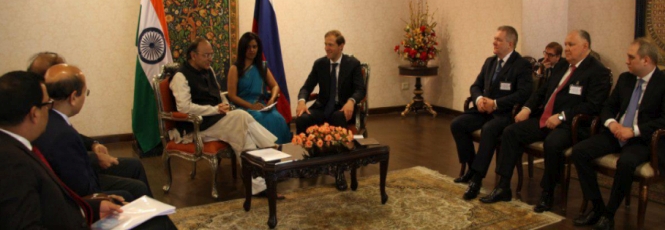WolfPack86
New Member
- Joined
- Oct 20, 2015
- Messages
- 10,571
- Likes
- 16,993
A number of Russian defence firms has broadly agreed to facilitate speedy repair and overhaul of Russian-origin military platforms in India and manufacture their spare parts through joint venture and technology transfer with Indian companies.
It has been a long-standing grievance of armed forces that the supply of critical spares and equipment from Russia takes a long time affecting maintenance of military systems procured from that country.
Indian defence firms held extensive deliberations with Russian giants for technology transfer and manufacturing of some parts and components of Russian-origin military systems in India and sources said the talks were fruitful.
Their talks took place during course of a conference on March 18 and 19 here on deepening defence engagement between the two countries. It was attended by more than 100 Russian and over 150 Indian industry representatives.
In a statement, the Defence Ministry said Russian firms showed keen interest in taking 'Make in India' further by involving Indian firms in the process of providing after-sales support of Russian origin equipment to the Indian Armed Forces through long-term supply agreements, repair, overhaul and manufacturing of some spare parts and components.
The conference was aimed at addressing issues relating to life-cycle support and maintenance of Su-30MKI aircraft, Mi-17 helicopters, Mig-29K jets, T-90 tanks and the aircraft carrier INS Vikramaditya, besides exploring ways to step up overall defence collaboration.
In his inaugural address, Defence Minister Arun Jaitley had asked Russia to adopt a liberal approach in sharing technology for components of Russian-origin defence platforms, saying it was critical to keep them in operational readiness.
Some major Russian companies which attended the deliberations include United Aircraft Corporation (UAC), United Engines Corporation (UEC), United Shipbuilding Corporation (USC), Russian Helicopters and Ural Vagonzavod.
These firms made detailed presentations on the possibilities of cooperation and the way forward in this regard.
During the conference, the Department of Defence Production outlined opportunities under 'Make in India' initiative and recent steps by the government to facilitate co-development, co-production, licence production between Indian and Russian companies.
The Russian side presented the framework for interaction between Federal Services for Military Technical Cooperation (FSMTC) and Indian partners in the field of after-sales support of Russian origin military equipment.
The conference also had three breakout sessions on aero system, land system and naval system where the Indian side expressed their requirements and the way forward to improve serviceability of Russian origin platforms, the Ministry said.
http://www.defencenews.in/article.aspx?id=251093
It has been a long-standing grievance of armed forces that the supply of critical spares and equipment from Russia takes a long time affecting maintenance of military systems procured from that country.
Indian defence firms held extensive deliberations with Russian giants for technology transfer and manufacturing of some parts and components of Russian-origin military systems in India and sources said the talks were fruitful.
Their talks took place during course of a conference on March 18 and 19 here on deepening defence engagement between the two countries. It was attended by more than 100 Russian and over 150 Indian industry representatives.
In a statement, the Defence Ministry said Russian firms showed keen interest in taking 'Make in India' further by involving Indian firms in the process of providing after-sales support of Russian origin equipment to the Indian Armed Forces through long-term supply agreements, repair, overhaul and manufacturing of some spare parts and components.
The conference was aimed at addressing issues relating to life-cycle support and maintenance of Su-30MKI aircraft, Mi-17 helicopters, Mig-29K jets, T-90 tanks and the aircraft carrier INS Vikramaditya, besides exploring ways to step up overall defence collaboration.
In his inaugural address, Defence Minister Arun Jaitley had asked Russia to adopt a liberal approach in sharing technology for components of Russian-origin defence platforms, saying it was critical to keep them in operational readiness.
Some major Russian companies which attended the deliberations include United Aircraft Corporation (UAC), United Engines Corporation (UEC), United Shipbuilding Corporation (USC), Russian Helicopters and Ural Vagonzavod.
These firms made detailed presentations on the possibilities of cooperation and the way forward in this regard.
During the conference, the Department of Defence Production outlined opportunities under 'Make in India' initiative and recent steps by the government to facilitate co-development, co-production, licence production between Indian and Russian companies.
The Russian side presented the framework for interaction between Federal Services for Military Technical Cooperation (FSMTC) and Indian partners in the field of after-sales support of Russian origin military equipment.
The conference also had three breakout sessions on aero system, land system and naval system where the Indian side expressed their requirements and the way forward to improve serviceability of Russian origin platforms, the Ministry said.
http://www.defencenews.in/article.aspx?id=251093



